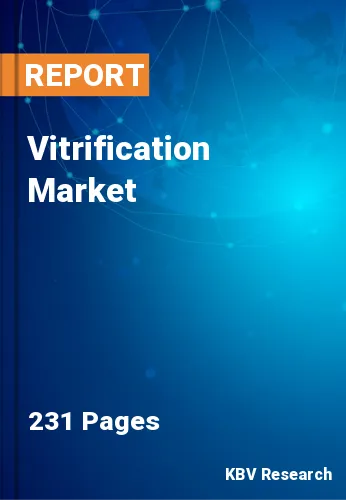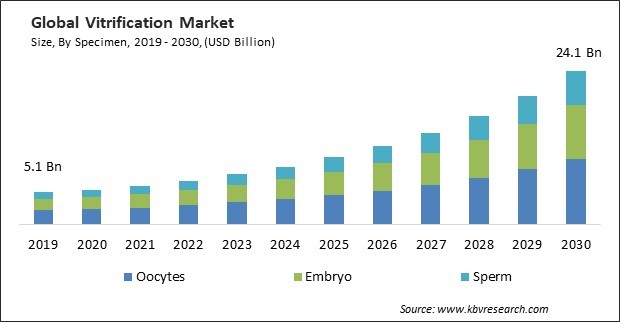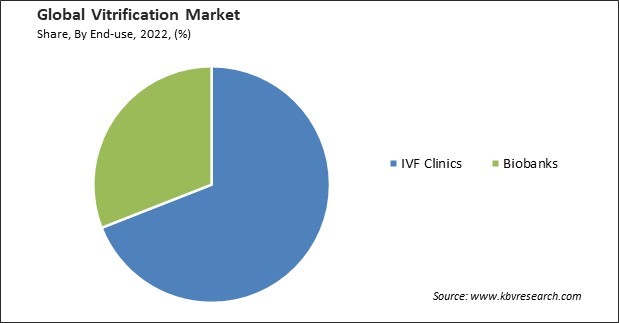
The Global Vitrification Market size is expected to reach $24.1 billion by 2030, rising at a market growth of 17.2% CAGR during the forecast period.
Male fertility preservation and sperm cryopreservation are both crucial components of ART. It can help individuals with azoospermia or oligozoospermia avoid recurrent biopsies. Thus, the sperm segment will capture 1/5th share in the revenue by the year 2030. Before having chemotherapy or radiation therapy, cancer patients can also use this procedure to maintain their fertility. The standard freezing approach can achieve an adequate survival rate since mature sperm have a significant number and little volume and also tolerate freezing temperatures well. Some of the factors impacting the market are growing demand for organ transplants, rising percentage of first-time mothers at an older median age and ethical, and technical issues with IVF and fertility preservation.

Various reasons, such as pointless injury, poisoning, blood loss, drug abuse, etc., can cause organ failure. The rising incidence of renal disease, excessive alcohol use, and poor diet have pushed the growth of organ transplantation. Growing global organ donation also influences people's attitudes toward organ transplantation. By transforming them into a glass-like condition, vitrification enables the conservation of organs at extremely low temperatures (-196°C or -320°F). This makes it possible to store organs for a long time—possibly from hours to days—without any actual degradation. Additionally, over time, there has been a sharp increase in the median age of first-time mothers globally. More effective contraceptive methods, later marriages, and an increase in women prioritizing their careers over having children are the leading causes of this trend. Because of this, it is projected that as the average age of first-time mothers increases, more women will experience trouble conceiving naturally. More women are being forced to seek IVF treatments in this situation. The market is, therefore, anticipated to grow along with the rise in demand for organ transplants.
However, some individuals dislike the idea of artificially created life that couldn't exist if nature were left to itself. Another argument they can raise is that "natural selection" should be allowed to carry out its task. The institution of monogamous marriage and the sanctity of human life are both affected by in vitro fertilization. For the children who are conceived, it also raises issues with identity. Even in its earliest phases, starting with conception, human life has immense significance. Legal issues that could affect society and healthcare professionals include allegations of medical malpractice, informed consent from patients who are minors, and legal parentage. These ethical and technical issues with IVF and fertility preservation may hinder the market's expansion.
Additionally, the COVID-19 pandemic had a significant effect on the global economy; the healthcare industry was not exempted from this. The pandemic had a negative impact on the market. International fertility associations advised against continuing IVF therapy during the World Health Organization's (WHO) COVID-19 pandemic, except for necessary medical fertility preservation. However, the relaxation of COVID-19 limitations allowed IVF clinics and other healthcare facilities to reopen with precautions like ensuring adequate staff and adhering to appropriate safety procedures. In light of these elements, these factors aided in the market's quick recovery in the post-pandemic era.
Based on end-use, the market is fragmented into IVF clinics and biobanks. In 2022, the IVF clinics segment witnessed the largest revenue share in the market. The significant revenue share may result from the growing number of IVF clinics that provide vitrification and other ART services. Furthermore, the clinics are providing services like sperm, egg, and oocyte storage, which is anticipated to increase the income share of clinics. Regarding the IVF progress rate and the number of freezing cycles for oocytes and embryos, the vitrification technique considerably enhances the reproductive health environment.

The embryo segment is further bifurcated into devices and kits & consumables. The devices segment acquired the largest revenue share in the market in 2022. Vitrification devices, such as straws, vials, or specialized containers, serve as protective enclosures for embryos. They keep embryos securely contained during the vitrification process, preventing direct exposure to cryoprotectant solutions and minimizing the risk of physical damage. Devices are engineered to hold specific volumes of vitrification solutions and embryos.
The oocytes segment is further subdivided into devices and kits & consumables. The kits and consumables segment procured a significant revenue share in the market in 2022. The success of oocyte vitrification in fertility preservation and ART depends on the quality of the materials and procedures used. Vitrification kits and consumables contribute significantly to the overall success rate of the technique, ensuring that oocytes are preserved with high viability and developmental potential.
On the basis of specimen, the market is segmented into oocytes, embryos, and sperm. In 2022, the embryo segment acquired a substantial revenue share in the market. Extra embryos are vitrified to preserve them. IVF practitioners transfer fewer fresh embryos into the uterus to reduce the chance of multiple pregnancies. A frozen embryo transfer may be performed if the first cycle is unsuccessful rather than going through the inconveniences of ovarian stimulation and egg retrieval again.
| Report Attribute | Details |
|---|---|
| Market size value in 2022 | USD 6.9 Billion |
| Market size forecast in 2030 | USD 24.1 Billion |
| Base Year | 2022 |
| Historical Period | 2019 to 2021 |
| Forecast Period | 2023 to 2030 |
| Revenue Growth Rate | CAGR of 17.2% from 2023 to 2030 |
| Number of Pages | 231 |
| Number of Table | 410 |
| Report coverage | Market Trends, Revenue Estimation and Forecast, Segmentation Analysis, Regional and Country Breakdown, Companies Strategic Developments, Company Profiling |
| Segments covered | Specimen, End Use, Region |
| Country scope | US, Canada, Mexico, Germany, UK, France, Russia, Spain, Italy, China, Japan, India, South Korea, Singapore, Malaysia, Brazil, Argentina, UAE, Saudi Arabia, South Africa, Nigeria |
| Growth Drivers |
|
| Restraints |
|
Region-wise, the market is analyzed across North America, Europe, Asia Pacific, and LAMEA. In 2022, the Europe region led the market by generating the largest revenue share. The existence of developed economies like those of France, Spain, Germany, the UK, and Italy is responsible for this. Because of the developed infrastructure in these nations, cryopreservation techniques are expected to increase dramatically in the region. Furthermore, the biotechnology sector's expansion and financial support for the development of assisted reproductive technologies in nations like the UK and Germany contribute to market growth. The high incidence of infertility and rising interest among women in egg preservation are the main drivers of regional development.
Free Valuable Insights: Global Vitrification Market size to reach USD 24.1 Billion by 2030
The market research report covers the analysis of key stakeholders of the market. Key companies profiled in the report include Vitrolife AB, Genea Limited (Liverpool Partners Group), NidaCon International AB, Minitüb GmbH, Cryo Bio System (IMV Technologies Group), CooperSurgical Fertility & Genomic Solutions (The Cooper Companies, Inc.), FUJIFILM Irvine Scientific, Inc. (Fujifilm Holdings Corporation), Biotech, Inc., Kitazato Corporation and Shenzhen VitaVitro Biotech
By Specimen
By End-use
By Geography
This Market size is expected to reach $24.1 billion by 2030.
Growing demand for organ transplants are driving the Market in coming years, however, Technical issues with IVF and fertility preservation restraints the growth of the Market.
Vitrolife AB, Genea Limited (Liverpool Partners Group), NidaCon International AB, Minitüb GmbH, Cryo Bio System (IMV Technologies Group), CooperSurgical Fertility & Genomic Solutions (The Cooper Companies, Inc.), FUJIFILM Irvine Scientific, Inc. (Fujifilm Holdings Corporation), Biotech, Inc., Kitazato Corporation and Shenzhen VitaVitro Biotech
The expected CAGR of this Market is 17.2% from 2023 to 2030.
The Oocytes segment is leading the Market, By Specimen in 2022; thereby, achieving a market value of $10.4 billion by 2030.
The Europe region dominated the Market, By Region in 2022, and would continue to be a dominant market till 2030; thereby, achieving a market value of $8.6 billion by 2030.
Our team of dedicated experts can provide you with attractive expansion opportunities for your business.
